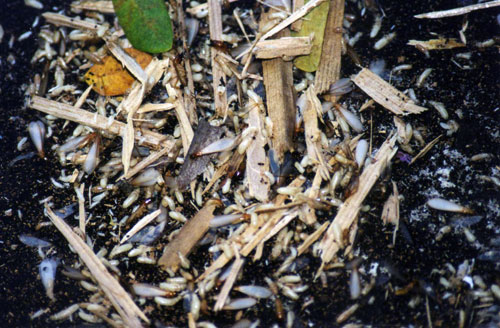| DRYWOOD TERMITES
FUMIGATION
The most effective method of control
is tent fumigation. There is only one fumigant used for the control
of drywood termites in Hawaii and it is VIKANE, sulfuryl fluoride.
It was developed in the 1950’s and has been widely used since
then. It is a transported as a liquid in pressurized cylinders but
vaporizes at 67 degrees Fahrenheit and it is toxic especially to
insects. It will control a broad range of insects but it is generally
used to control drywood termites as there are usually more inexpensive
ways of treating roaches and other pests. Different insects will
be killed with different doses of VIKANE so an insect with a high
metabolism, such as a fly, will succumb much quicker than termites.
Spiders, with very low metabolic rates, will require twice as much
fumigant as termites. Another variable is not just the quantity
on the fumigant introduced to the structure but the length of time
it is kept there. Therefore, a structure can be fumigated for a
shorter period of time if the quantity of the fumigant is increased.
The dosage also depends on a number of factors such as the type
of soil under the building, the wind speed, the ambient temperature
and how well contained the gas is. Fumigation of houses is a real
blend of science and art. Its objective is to confine a sufficient
amount of gas for a long enough time to allow it to penetrate all
the areas of the house and kill all the termites. VIKANE is effective
not just because it is toxic but because it is able to penetrate
deep into the wood through the pores. These pores are so small they
can only be seen with an electron microscope. Being able to penetrate
into openings this small it can easily penetrate the relatively
large termite galleries. This penetration is called sorption. Another
desirable quality of VIKANE is it’s rate of desorption. It
does not bind with the wood and everything else in the house and
leave a residue. The gas diffuses from areas of higher concentrations
to areas of lower concentrations so while the tent covers the house
and contains the gas it moves to areas where there is little or
no gas. Once the tent is removed the diffusion continues to the
outside where there is no gas until all the gas has escaped. The
gas is heavier than air so circulating fans are used inside the
house to insure that areas such as the attic and rafters are covered.
Once released into the
atmosphere it is broken down through hydrolysis.

REPLACEMENT OF
INFESTED MATERIALS
Replacement of the infested material works but only when
you can be sure all the areas if infestation have been identified.
This may be appropriate in a condominium when the front door has
been heavily infested and damaged and the likelihood of spot treatment
being effective is not good.
SPOT TREATMENT
Spot treatment can sometimes be effective when there is a limited
infestation and it is accessible. An insecticide is injected into
the termite galleries. If it reaches the termites they are instantly
killed. The problem is getting it to the termites. The biggest failure
results when the infestation is large and the insecticide doesn’t
penetrate adequately or when there are infestations that are not
visible. Treating plywood is difficult as the liquid does not penetrate
the various layers especially with thicker pieces.
A variation on this is the application of Tim-bor
to the surfaces of the wood. Tim-bor is a combination of sodium
oxide and boric oxide applied with water. It is used to pressure
treat lumber at a facility at Campbell Industrial Park but can also
be used by a licensed pest control operator with a license to use
restricted use pesticides. According to the manufacturer, applying
it to the surfaces of wood will kill termites inside the wood. The
limitations are that it can not be used where it will be washed
away with rain, it should be applied to an unpainted surface and
some infestations may be inaccessible such as those inside wall. |






